
Dimocarpus longan, commonly known as the longan, is a tropical tree species that produces edible fruit. It is one of the better-known tropical members of the soapberry family Sapindaceae, to which the lychee and rambutan also belong. The fruit of the longan is similar to that of the lychee, but less aromatic in taste. It is native to tropical Asia and China.

Lychee is the sole member of the genus Litchi in the soapberry family, Sapindaceae.

Melicoccus bijugatus, genip, guinep, genipe, ginepa, kenèp, quenepa, quenepe, quenette, chenet, talpa jocote, mamón, limoncillo, canepa, skinip, kinnip, huaya, or mamoncillo, is a fruit-bearing tree in the soapberry family Sapindaceae, native or naturalized across the New World tropics including South and Central America, and parts of the Caribbean. Its stone-bearing fruits are edible.
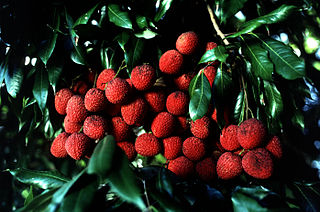
The Sapindaceae are a family of flowering plants in the order Sapindales known as the soapberry family. It contains 138 genera and 1858 accepted species. Examples include horse chestnut, maples, ackee and lychee.

Dimocarpus is a genus of about 20 species of trees or shrubs known to science, constituting part of the flowering plant family Sapindaceae. They grow naturally in tropical south and Southeast Asia, Malesia, Papuasia and Australasia, including Sri Lanka, India, the Philippines, southern China, Taiwan, Burma, Cambodia, Vietnam, Malaysia, Indonesia, New Guinea, East Timor, far north-eastern Queensland Australia.

Jagera is a genus of 4 species of forest trees known to science, constituting part of the plant family Sapindaceae.

Nephelium hypoleucum, the korlan, is a tree in the family Sapindaceae. It is closely related to several other tropical fruits including the lychee, longan, rambutan, and mamoncillo.
Albonectria rigidiuscula is a fungal plant pathogen. The anamorph of A. rigidiuscula the fungus Fusarium decemcellulare is associated with inflorescence wilt and vascular necrosis in fruit tree crops such as Mango, Longan and Rambutan. F. decemcellulare causes a disease known as cushion gall in Theobroma cacau and other tropical trees.

Pyrops candelaria is a species of planthopper that lives in Cambodia, Vietnam, Hong Kong, Laos, Thailand and other parts of southeast Asia. It is the type of the genus Pyrops erected by Spinola in 1839. Members of this genus are sometimes called lanternflies. Like all Fulgoridae, P. candelaria feeds on plant sap: including longan and lychee trees (Sapindaceae), among others. Its long, slender proboscis is used to pierce tree bark to reach the phloem.
Dimocarpus yunnanensis is a species of tree native to China related to the longan. They are usually 10 feet (3.0 m) tall when fully grown. The drupes are small and inedible. They are sometimes grown in gardens as ornamental plants.
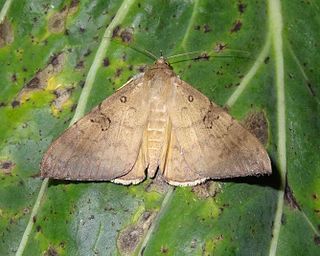
Oxyodes scrobiculata, the longan semi-looper or longan leaf-eating looper, is a moth of the family Erebidae. The common name "looper" is used despite looper moths generally being in the family Geometridae. The species was first described by Johan Christian Fabricius in 1775. It is found from the Indo-Australian tropics of India, Sri Lanka, Myanmar, China, east to Guam, Queensland, New Caledonia, Fiji, Samoa and Tonga.
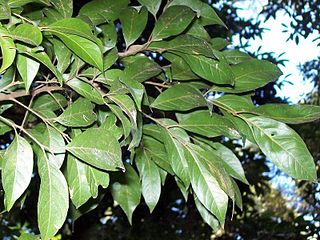
Sarcopteryx is a genus of about 12 rainforest tree species known to science, of the plant family Sapindaceae. They occur in Australia, New Guinea and the Moluccas.
Tristiropsis is a genus of about 14 flowering trees species, of the plant family Sapindaceae.

Mischarytera is a genus of rainforest trees, constituting part of the plant family Sapindaceae. Four species are known to science as of December 2013, found growing naturally in eastern Queensland, Australia, and in New Guinea. Formerly until 1995, they had names within the genus Arytera, subgenus Mischarytera.
Synima is a genus of tropical rainforest trees, constituting part of the plant family Sapindaceae.
Cnesmocarpon is a genus of 4 species of rainforest trees known to science, constituting part of the plant family Sapindaceae.
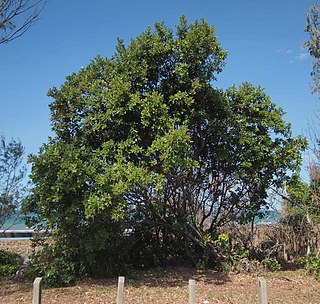
Alectryon connatus, sometimes named hairy alectryon, is a species of small trees, constituting part of the plant family Sapindaceae.
Pieter Willem Leenhouts was a Dutch botanist. He worked at the Rijksherbarium from 1947 until his official retirement in 1991, and then was an honorary member of staff until 1999. He was editor of Blumea from 1973 to 1999.
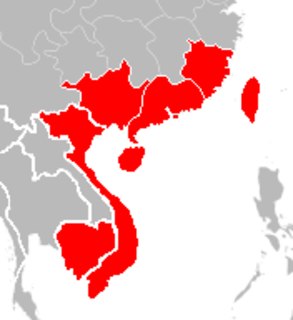
Longan witches broom-associated virus is a species of positive-sense single-stranded RNA virus that has not been assigned to a genus within the family Potyviridae. It is thought to be the cause of witch's broom in longan, a large tropical tree from southeastern Asia of economic value. Longan witches broom disease is a condition that was first described in 1941. The virus was found in symptomatic plants and absent in healthy plants, but not all of Koch's postulates have been fulfilled.











